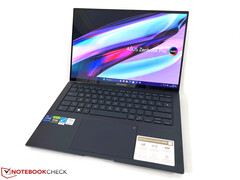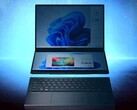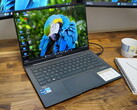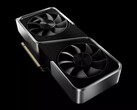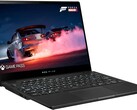Asus' Zenbook Pro Duo has been around for some time now and is clearly aimed at creative users or content creators with the second screen above the keyboard. However, the second screen also creates disadvantages, such as the thicker case, the increased weight and the position of the keyboard. The new Zenbook Pro 14 is once again a regular and powerful notebook with a screen that combines the new Raptor Lake chips from Intel with the current GeForce RTX GPUs from Nvidia.
The 14-incher is quite beefy, but hides its depth very well thanks to its design. So there is also enough space in the case for the cooling, which handles the fast RTX 4070 Laptop GPU very well. This is the 95-watt version, which is quite a feat for a 14-inch device - although you'll have to use the optional Performance mode to really exhaust the GPU's full power. The performance of the Core i9-13900H is also very good.
Asus uses OLED displays on many devices, and the Zenbook Pro 14 is no exception, although the 120 Hz OLED is a first. Of course, movements on the screen benefit from this, but the subjective image impression is not perfect since the touchscreen results in a slightly grainy image impression. The other specs correspond to the usual values for current OLED screens: SDR brightness of around 360 Hz and a maximum HDR brightness of more than 550 cd/m². Color accuracy is excellent thanks to the preinstalled profiles and the P3 color space is fully covered. At brightness values of 50% and above, DC dimming is used, including the traditional and potentially harmful PWM flickering. On the other hand, Asus offers flicker-free OLED dimming, with which the brightness can be reduced without entering the harmful PWM range. However, we would like to see this function integrated directly into the regular Windows brightness control so that you don't always have to go through the MyAsus software.
The Zenbook Pro 14 is clearly a direct competitor to Apple's MacBook Pro 14, also in terms of price. In terms of HDR capabilities, Apple is clearly ahead because its implementation of HDR into the operating system works flawlessly and the mini-LED screen reaches more than 1,500 cd/m² with the appropriate content. In addition, the MacBook has longer battery life and also better speakers, but no upgrade options and the raw performance of the Zenbook Pro 14 is simply greater (at least in mains operation).
Overall, Asus has created a very good multimedia notebook in the new Zenbook Pro 14, which is by no means a bargain at around EUR 3,500 (~US$3,800). We also see room for improvement in some aspects, such as the somewhat grainy image impression or the somewhat rickety keyboard. All other information about the device is available in our detailed review:




